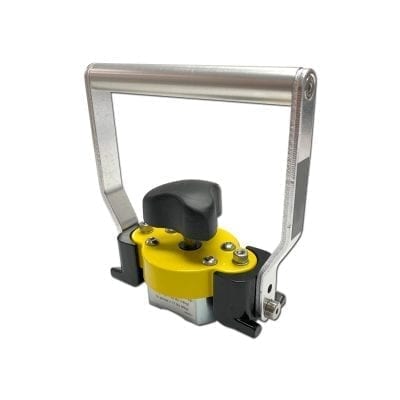

Each gripper carries three switchable magnets and three rubber pads to increase friction and prevent slippage, and they are designed in two steps. This paper presents the design and implementation of novel magnetic grippers for the HyReCRo robot, which is a biped robot to climb and explore steel structures. These tasks can be safely performed with the help of inchworm-like climbing robots, which use magnetic grippers to adhere, climb, and explore steel structures. Steel structures require inspection and maintenance tasks which are too dangerous for human workers, due to the risk of falling from heights. This will inevitably lead to future experimental research and development work. However, vacuum based design and adaption requires thought for meat surface and structure variance. In conclusion, the simple vacuum-based system offers the best solution of holding force and low damage thresholds. Three pneumatic-based unilateral gripper principles, namely Coanda, Bernoulli and Vacuum, are critically reviewed for their feasibility in meat industry automation. The focus is on air-driven grippers due to their ability to hold high payloads without causing visual and physical damage to the payload. Criteria for such tooling are simplicity, low-cost, durability and robustness, whilst being capable of gripping highly deformable objects of various structures and maintaining safety and hygiene standards. This paper critically reviews various unilateral gripping solutions available in cross-industry sectors or developed in research that could be used or adapted for the meat industry. This includes grippers used to hold, manipulate and transport workpieces, such as primal cuts of red meat, for example, with the simplest type being unilateral gripping systems. However, to achieve such autonomous nirvana, simple, cost-efficient and robust tooling to support these systems are sought.

Changes to current abattoir setups and processes are necessary to realise for sustainable, low-cost and scalable automation. With the expectation that meat consumption will grow by 12% over the next decade, coupled with the reported labour issues and viruses attacking human and animal health, there is a growing requirement for red meat slaughterhouse automation. The feasibility of the proposed robot is shown through a prototype. Thanks to this, the poses reachable by the proposed robot are doubled, granting it a denser workspace and more accuracy than similar robots, using only two binary actuators. The 2RPR-PR chain can perform nonsingular transitions, which is the ability of many parallel robots to switch between different poses corresponding to the same state of its actuators, without crossing singularities. To solve this, this paper presents a new sliding-frame robot consisting of two bodies connected through a 2RPR-PR kinematic chain driven by two binary actuators. However, most existing sliding-frame robots require continuous actuators to reach targets with precision, since binary actuators impose steps of fixed length. Sliding-frame robots are simpler and offer safer adhesion than legged and wheeled robots, and their control can be simplified using binary actuators that adopt only two stable states. They move by alternately adhering one body to the structure while moving the other body to the next position. Sliding-frame mobile robots used for autonomously inspecting metallic structures consist of two bodies connected by few joints. We propose a locomotion based on performing rotations of 180 ∘, which we demonstrate to be the minimum-time solution for long trajectories, and a near-optimal solution for shorter ones. In this paper, we solve the planar trajectory tracking problem of this robot for polygonal paths made up of sequences of segments, which may include narrow corridors that are difficult to traverse. By alternately releasing or attaching these adhesion pads to the environment, the proposed robot is able to pivot about different axes using only one motor, with the possibility of performing concave plane transitions or combining with other identical modules to build more complex reconfigurable robots. This paper presents the MASAR, a new Modular And Single-Actuator Robot that carries a single motor and several adhesion pads. By using auxiliary binary mechanisms that redirect and channel the driving force of their only actuator in different ways, it is possible for these robots to perform higher-dimensional motions, such as walking straight, steering, or jumping, with only one motor. Single-actuator mobile robots offer the benefits of low energy consumption, low weight and size, and low cost, but their motion is typically only one-dimensional.


 0 kommentar(er)
0 kommentar(er)
